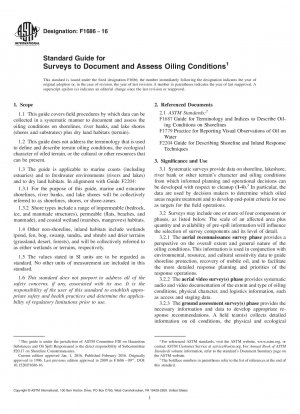ASTM F1686-16
Standard Guide for Surveys to Document and Assess Oiling Conditions
- Standard No.
- ASTM F1686-16
- Release Date
- 2016
- Published By
- American Society for Testing and Materials (ASTM)
- Status
- Replace By
- ASTM F1686-22
- Latest
- ASTM F1686-22
- Scope
3.1 Systematic surveys provide data on shoreline, lakeshore, river bank or other terrain’s character and oiling conditions from which informed planning and operational decisions can be developed with respect to cleanup (1-4).3 In particular, the data are used by decision makers to determine which oiled areas require treatment and to develop end-point criteria for use as targets for the field operations.
3.2 Surveys may include one or more of four components or phases, as listed below. The scale of an affected area plus quantity and availability of pre-spill information will influence the selection of survey components and its level of detail.
3.2.1 The aerial reconnaissance survey phase provides a perspective on the overall extent and general nature of the oiling conditions. This information is used in conjunction with environmental, resource, and cultural sensitivity data to guide shoreline protection, recovery of mobile oil, and to facilitate the more detailed response planning and priorities of the response operations.
3.2.2 The aerial video survey(s) phase provides systematic audio and video documentation of the extent and type of oiling conditions, physical character, and logistics information, such as access and staging data.
3.2.3 The ground assessment survey(s) phase provides the necessary information and data to develop appropriate response recommendations. A field team(s) collects detailed information on oil conditions, the physical and ecological character of oiled areas, and resources or cultural features that may affect or be affected by the timing or implementation of response activities.
3.2.4 The post-treatment inspection ground survey or monitoring phase provides the necessary information and data to ensure a segment, that is part of the response program, has been treated to the approved end-point criterion. (5)
3.3 In order to ensure data consistency, it is important to use standardized terminology and definitions in describing oiling conditions, as provided in Guide F1687. This terminology is described in more detail in guidelines on Best Practices and checklists for the implementation of a survey program (1-4).
1.1 This guide covers field procedures by which data can be collected in a systematic manner to document and......
ASTM F1686-16 Referenced Document
- ASTM F1687 Standard Guide for Terminology and Indices to Describe Oiling Conditions on Shorelines
- ASTM F1779 Standard Practice for Reporting Visual Observations of Oil on Water
- ASTM F2204 Standard Guide for Describing Shoreline Response Techniques
ASTM F1686-16 history
- 2022 ASTM F1686-22 Standard Guide for Surveys to Document and Assess Oiling Conditions
- 2016 ASTM F1686-16 Standard Guide for Surveys to Document and Assess Oiling Conditions
- 2009 ASTM F1686-09e1 Standard Guide for Surveys to Document and Assess Oiling Conditions on Shorelines
- 2009 ASTM F1686-09 Standard Guide for Surveys to Document and Assess Oiling Conditions on Shorelines
- 1997 ASTM F1686-97(2003) Standard Guide for Surveys to Document and Assess Oiling Conditions on Shorelines
- 1997 ASTM F1686-97 Standard Guide for Surveys to Document and Assess Oiling Conditions on Shorelines

Copyright ©2024 All Rights Reserved